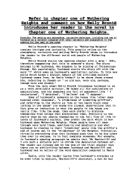‘...and by a range of gaunt thorns all stretching their limbs one way, as if craving alms of the sun’
, which could show a deficiency of sunlight , this always shows a place of goodness and as such shows an lack of goodness here. This shows that an occurrence may be pending which concurs with the preceding descriptions theme. There are also references to disturbing nature and language,’...surrounded by swarm of squealing puppies; and other dogs haunted other recesses.’ The part when Lockwood gets attacked by the dogs is another bad occurrence which may propose that this place has strange goings on. These events are brought together in the back of the sreaders mind which constructs an anticipation of a climactic event approaching.
These dreams wouldn’t have been as effective without the language used in this passage of the novel. Bronte’s use of language is
very Feminist criticism has seen the novel in terms of its language, and in terms of its strategies and opportunities that are open to women in the novel. Feminist and gender criticism has also provided some interesting readings of the ambivalent representations of gender in the dreams and in the novel as a whole, not the least of which ‘Gilberts and Gubar’s’ reading of Heathcliff as ‘female’ because he is dispossessed of social power. He has no status, no social place and no property. He is only Heathcliff, never Mr. Heathcliff, or the master in contrast to Edgar Linton. Bronte rights Heathcliff to have rebellions against the social conventions of class; marriage and inheritance similarly suggest that he can be read as ‘female’, which suggests these qualities in the society’s view of ‘stereotypical’ women, since endorsing such conventions only serves the interests of patriarchal culture.
These dreams that Lockwood have can influence our understanding of what is to come. Now that the dreams have occurred we have understanding of the social arrangement of people and we also understand that there must be some grounds for the aloof and detached character of Heathcliff, so we can begin to value the importance of Cathy having some relevance to Heathcliff’s nature and this obliges the reader think there must be an episode involving them both which scarred Heathcliff in this way. The second dream leads the reader to trust that this girl, who was in the dream, was of great significance to Heathcliff, as he moans to the plain moors in front of him for Cathy to return after 20 years, which insinuates a lingering for this girl. The reader may think that this girl has a part to play in this novel yet to come because of these references to her importance.
The dreams which occur in the novel have an overall indispensable quantity in the novel, without these dreams we could not understand a vast lot of the story which follows. I believe these dreams to be of great significance to the rest of the novel also because they add to the overall effect of indistinct nature of this story which is of what drew me to the book in the first place.







